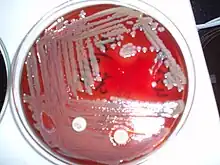Flavobacteriia
| Flavobacteriia | |
|---|---|
 | |
| Elizabethkingia meningoseptica on blood agar | |
| Scientific classification | |
| Domain: | Bacteria |
| Phylum: | Bacteroidota |
| Class: | Flavobacteriia Bernardet 2012[1] |
| Orders[2] | |
| |
The class Flavobacteriia is composed of a single order of environmental bacteria.[3] According to Bernardet et al., Flavobacteriia are Gram-negative aerobic rods, 2–5 μm long, 0.3–0.5 μm wide, with rounded or tapered ends that are motile by gliding, yellow (cream to orange) colonies on agar, decompose several polysaccharides but not cellulose, G+C contents of 32–37%, and are widely distributed in soil and fresh and seawater habitats.[4] In particular, Flavobacteriia are prominent members of marine biofilms.[5] The type species Flavobacterium aquatile was isolated from a well in Kent, England.[6]
Flavobacteriia are a group of commensal bacteria and opportunistic pathogens. Flavobacterium psychrophilum causes the septicemic diseases rainbow trout fry syndrome and bacterial cold water disease.
The name is often spelled Flavobacteria, but officially named Flavobacteriia in 2012.[7][8]
References
- ↑ Bernardet J-F. (2010). "Class II. Flavobacteriia class. nov.". In Krieg NR, Staley JT, Brown DR, Hedlund BP, Paster BJ, Ward NL, Ludwig W, Whitman WB (eds.). Bergey's Manual of Systematic Bacteriology. Vol. 4 (2nd ed.). New York, NY: Springer. p. 105.
- ↑ Euzéby JP, Parte AC. "Flavobacteriia". List of Prokaryotic names with Standing in Nomenclature (LPSN). Retrieved June 29, 2021.
- ↑ Bergey's Manual of Systematic Bacteriology, 2nd ed., vol. 1 (The Archaea and the deeply branching and phototrophic Bacteria) (D.R. Boone and R.W. Castenholz, eds.), Springer-Verlag, New York (2001). pp. 465-466.
- ↑ Buchan, Alison; LeCleir, Gary R.; Gulvik, Christopher A.; González, José M. (2014). "Master recyclers: features and functions of bacteria associated with phytoplankton blooms". Nature Reviews Microbiology. 12 (10): 686–698. doi:10.1038/nrmicro3326. ISSN 1740-1526. PMID 25134618.
- ↑ Briand, Jean-François; Misson, Benjamin; Le Poupon, Christophe; Durrieu, Gaël; Garnier, Cédric; Berdjeb, Lyria; Pollet, Thomas (2018-06-01). "Prokaryotic community successions and interactions in marine biofilms: the key role of Flavobacteriia" (PDF). FEMS Microbiology Ecology. 94 (6). doi:10.1093/femsec/fiy083. ISSN 0168-6496. PMID 29733333.
- ↑ "Flavobacterium aquatile (Frankland and Frankland) Bergey et al. ATCC &". www.atcc.org. Retrieved 2019-04-19.
- ↑ Bernardet, J.-F.; Bowman, J. P. (2013). "International Committee on Systematics of ProkaryotesSubcommittee on the taxonomy of Flavobacterium and Cytophaga-like bacteria: Minutes of the meetings, 7 September 2011, Sapporo, Japan". International Journal of Systematic and Evolutionary Microbiology. 63 (Pt 7): 2752–2754. doi:10.1099/ijs.0.053926-0. PMID 23825377. Archived from the original on 2014-10-31.
- ↑ "Flavobacteriia class". allmicrobes.com. Archived from the original on 1 November 2014. Retrieved 1 November 2014.
External links